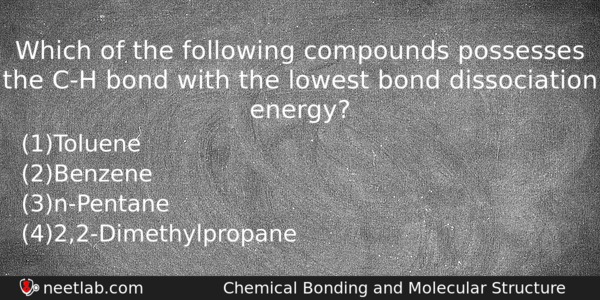| ⇦ | 
| ⇨ |
Which of the following compounds possesses the C-H bond with the lowest bond dissociation energy?
Options
(a) Toluene
(b) Benzene
(c) n-Pentane
(d) 2,2-Dimethylpropane
Correct Answer:
Toluene
Explanation:
Structure of Toluene:
Toluene (C₆H₅CH₃) = 85 kcal/mol
Benzene (C₆H₆) = 110 kcal/mol
n-Pentane (CH₃CH₂CH₂CH₃ ) = 98 kcal/mol
2, 2-Dimathylpropane = 92 kcal/mol
Toluene has the lowest C – H bond dissociation energy compare to other three.
Toluene is a Tertiary free radical. Bond Dissociation Energy of C-H bonds decreases as we go from methyl to primary to secondary to tertiary. They are easier to break since homolytic bond cleavage results in a more stable radical.
Related Questions: - Benzaldehyde gives a position test with
- Which one of the following explains light both as stream of particle and as wave
- The wavelength correspending to maximum enregy for hydrogen is 91.2 nm
- Cobalt(III) chloride forms several octahedral complexes with ammonia.
- An example of amino acid containing benzene ring is
Topics: Chemical Bonding and Molecular Structure
(86)
Subject: Chemistry
(2512)
Important MCQs Based on Medical Entrance Examinations To Improve Your NEET Score
- Benzaldehyde gives a position test with
- Which one of the following explains light both as stream of particle and as wave
- The wavelength correspending to maximum enregy for hydrogen is 91.2 nm
- Cobalt(III) chloride forms several octahedral complexes with ammonia.
- An example of amino acid containing benzene ring is
Topics: Chemical Bonding and Molecular Structure (86)
Subject: Chemistry (2512)
Important MCQs Based on Medical Entrance Examinations To Improve Your NEET Score
18000+ students are using NEETLab to improve their score. What about you?
Solve Previous Year MCQs, Mock Tests, Topicwise Practice Tests, Identify Weak Topics, Formula Flash cards and much more is available in NEETLab Android App to improve your NEET score.
Share this page with your friends

Why the other three options are not correct explain the reason for wrong options
Updated the explanation section with the answer.